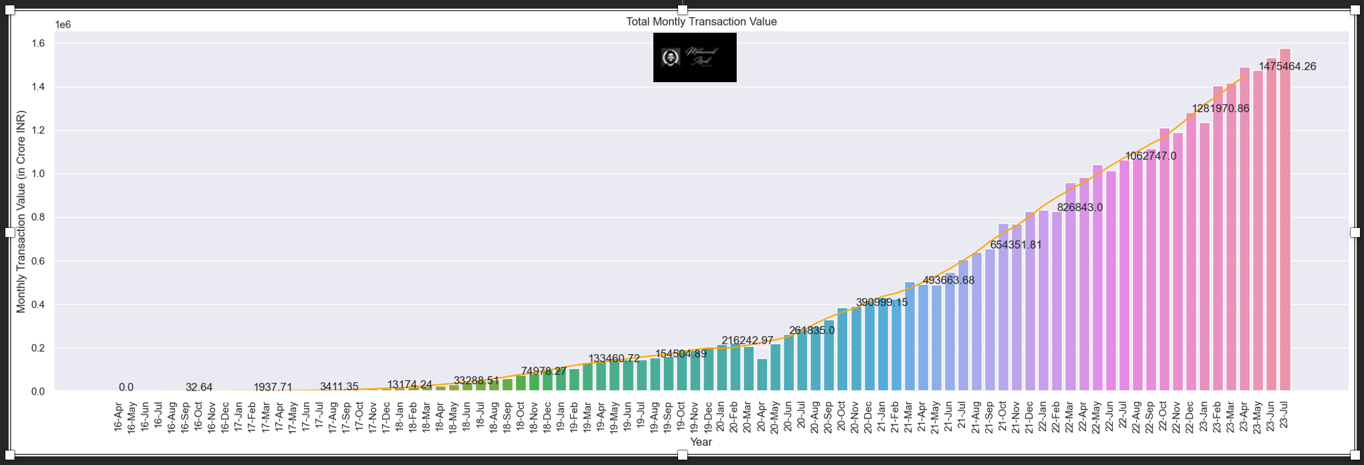In a groundbreaking research study, Mohammad Asad, a postgraduate student from the esteemed Indian Institute of Technology Kanpur (IITK), sheds light on the transformative journey of the Unified Payment Interface (UPI) as it emerges as India’s foremost financial innovation. Launched in Q2 2016 by the National Payment Corporation of India (NPCI) in alignment with the government’s cashless economy initiative, UPI has not only proven to be a cost-effective breakthrough for digital payment services but has also become a cornerstone in reshaping the nation’s financial landscape.
Asad’s extensive analysis, leveraging Machine Learning, offers valuable insights into UPI’s evolution, its impact on the digital economy, contributions to financial literacy, and future trends. Let’s delve into the key findings that illuminate UPI’s success and trajectory.
Unprecedented Growth in Financial Institutions:
Commencing with 21 banks, apps, and financial institutions, UPI has experienced a meteoric rise to encompass over 350 platform partners by mid-2023, demonstrating an impressive average onboarding rate of 35% over the past three years.
Outshining Traditional Payment Methods:
UPI has surpassed Credit Cards and Immediate Payment Service (IMPS) in India, establishing a significant lead in terms of yearly transaction value. Notably, UPI has exhibited an extraordinary average growth rate of 90% over the last three years, outpacing other payment methods.
● IMPS has maintained continuous positive growth, averaging 35% over the same period.
● Despite a declining overall growth rate, Credit Cards have sustained a positive average growth of 10%.
● National Electronic Funds Transfer (NEFT) has witnessed an average decline of -1.3%.
● Real Time Gross Settlement (RTGS) has experienced the least growth, with an average decline of -10% over the last three years.
These growth rates exclude the ongoing year 2023 since this study was done by mid 2023. The COVID-19 pandemic and lockdowns acted as catalysts propelling UPI’s exponential growth and adoption.
Exponential Growth in UPI Transactions:
Both the volume and value of UPI transactions have showcased remarkable year-on-year growth, averaging above 90% over the past three years (excluding 2023).
Milestones Achieved and Anticipated:
The UPI milestone timeline reveals its rapid ascent:
● Crossed 1 Billion monthly transactions in October 2019.
● Surpassed 10 Billion monthly transactions in July 2023.
● Achieved 1 Billion USD monthly transactions value in November 2017.
● Surpassed 10 Billion USD monthly transactions value in November 2018.
● Surpassed 100 Billion USD monthly transactions value in December 2021.
As per Asad’s predictions, UPI is expected to surpass NEFT in yearly transactions value, becoming the second-largest payment platform by Q1 2025. The anticipated total yearly transactions volume is expected to exceed 200 Billion by January 2025.
User Segmentation and Financial Inclusion:
Utilizing the KMeans Algorithm, Asad identified three distinct clusters based on Monthly Average Transactions Value per Million Transactions:
• High Value per Million transactions with Low Volume.
• Low Value per Million transactions with Low Volume.
• Medium Value per Million transactions with High Volumes.
As UPI adoption matured, a new segment emerged, indicating mass adoption for low to medium-value daily transactions. This trend reflects the ecosystem’s maturation and people settling with this fintech innovation.
Outcomes and Anticipations:
Based on the study, several striking findings and anticipated results include:
● The average ticket size of UPI transactions has significantly decreased, signifying mass adoption for low to medium-value transactions.
● By Q1 2025, the total yearly value of UPI transactions is expected to surpass the GDP of countries like Germany and Japan.
● UPI is poised to play a pivotal role in financial inclusion for students, youth, and individuals with low annual incomes, contributing to GDP growth calculations.
● UPI stands as India’s single most significant financial instrument, propelling the transition of the unorganized sector towards an organized economy.
Conclusion:
In conclusion, UPI stands as a beacon of financial innovation, not only revolutionizing India’s financial landscape but also poised to make a global impact. Mohammad Asad’s meticulous study, employing Machine Learning techniques, provides a comprehensive understanding of UPI’s impact, growth, and its pivotal role in shaping India’s economic future. In his opinion, “UPI is the single biggest Financial Innovation from India to the world”.
For further details, access the full findings of the Unified Payments Interface (UPI) study conducted by Mohammad Asad on his website txtviews.com.
Author:

Mohammad Asad,
Indian Institute of Technology Kanpur


